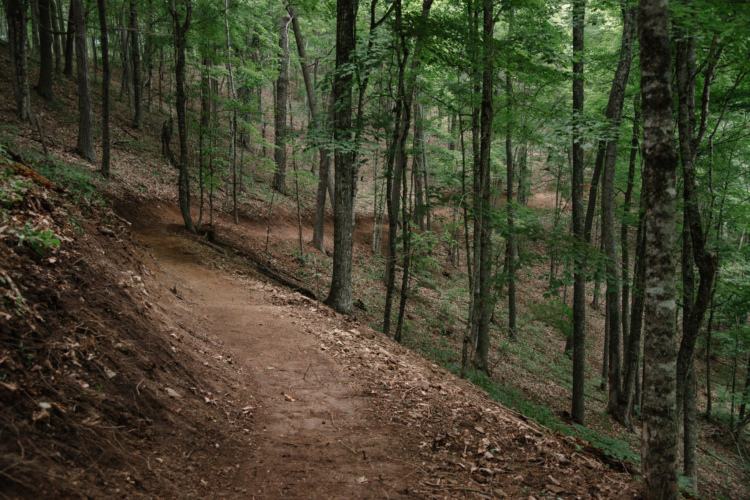
Any opinions expressed in this article belong to the author alone, and do not necessarily represent the opinions of Singletracks.com.
As I finished up my last ride of 2020, I rounded a corner and headed into a descent down a road in a nearby park. Picking up speed, I looked left on the parallel piece of singletrack and watched a mountain biker start his descent. He was wearing jeans, athletic shoes, a jacket, and no helmet. With his right hand holding the bars steady, his left held a phone vertically and recorded his descent, with freshly dried trail unrolling in front of him.
Safe? Probably not. Amazing? Most definitely. Presumably, the rider was new to mountain biking and having such a good time that he couldn’t help but whip out his phone, and record the oncoming dirt so he could export the experience to friends on social media.
Last year caught the mountain bike world off guard, myself included. As I noted in a story from last year, I posted a full-suspension bike of mine for sale in March before the pandemic got real. When restaurants and ski resorts closed up shop, and people around the world started losing their jobs, I assumed that I’d be hanging on to my unwanted bike for a while, but the opposite quickly proved true. A day after the Colorado governor announced the first stay-at-home order, I got three or four offers and the bike sold.
Our corner of the world always seems like a privilege and a luxury. For many, it is. Premium, full-suspension mountain bikes are a Ford Raptor, when a busted up Corolla would get us from point A to B. Nice bikes are completely unnecessary, yet absolutely vital to those who make it a lifestyle.
As we know now, bikes became a hot commodity after we settled into our hermit routines. Riding a bike is easy to do from home or close to home, it’s a low risk activity for virus transmission between others on the trail, and far more fun than sitting in a stadium next to annoying drunkards, watching other people play sports.
Like Jim Hodgson told Jeff Barber last month, “If you asked me a year ago what was keeping people from riding, I’d have said, well, maybe they don’t feel fit enough, maybe they don’t want to spend thousands on bikes, maybe they don’t know where to go.
I think we’ve learned from the pandemic that cycling was never competing with any of that. It was competing with bars and sports.”
Therein lies the assumption, that when sports balls start flying again, when silver screens see the glow of a projector, when bartenders can legally serve up celebration shots after doctors hand out the last of their shots, the mountain bike and cycling world will return to normal. Unless of course, busier trails and sold out bike shops are the new normal.
Before 2020 finished, I spoke with a marketing rep from a bike brand who thought this could be the case. They had had a record number of sales in 2020 and couldn’t order any extra bikes for 2021, because their factory time had been booked long before they knew they would need more. Before 2020 was over, the company was booking their production time for 2022, confident that the “bike boom” wouldn’t be a bust the following year, and that the cycling world will retain many of the new riders we saw on the trails.
Now, there are certainly downsides to this, but by and large it feels mostly positive. I have a handful of friends, if not two handfuls, that bought their first mountain bike this summer and were stoked to start a new sport. If you, like me, have always tried to convince friends that mountain biking is as cool as you say it is, you know that the conversation got much easier this past year.
The downsides of course include busier trails, and poor etiquette, as well as a more complicated experience trying to shop for bikes, bike parts, or getting into a shop for a repair. The positives though surely carry more weight. Assuming land managers are paying attention, we should expect to see an increase in trails in the coming years to spread out traffic and mitigate overuse. If they aren’t paying attention, make them.
After the supply chain strains that are currently increasing costs on mountain bikes subside, the market as a whole should become more affordable with a greater base of customers. Hopefully the carbon “super bike” brands see the value in this, and they can eventually lower prices, as a reflection of scale and competition, just like the car world. If we can get 15 different variations of a Mustang these days, with seven different motors, we should (eventually) be able to get more than three build options on the same carbon frame.
In 2021, veteran mountain bikers can set the tone for new riders and the industry alike. Take a friend out who just bought a new bike, and be patient with them for goodness sake. Stop and ask them if they’d like to session a feature they’re having trouble with, but avoid being the mansplainer and put the decision in their hands.
Show them how to yield to hikers and uphillers, and give mountain bikers a positive reputation. Invite them out on a dig day. If more mountain bikers understand the amount of work it takes to get a trail built and keep it in good shape, there’s a good chance that mountain bike organizations will have more money to build more trails.
Most importantly, share the excitement. Like many, I’ve been upset with the increase in traffic on the trails this year. No one wants to kill their flow, turn after turn. But, positivity begets positivity, and how disillusioned is it to hope that other people don’t find the things that give you joy?
Pandemic restrictions are still alive and well for most of the world and it doesn’t look like things will get much easier in that regard until later in the year. I’m positive though, that it will be another good year for mountain bikers and bicycle riders as long as we can keep pedaling.









